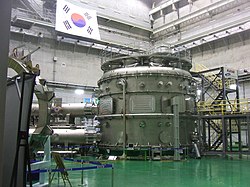The KSTAR (orKorea Superconducting Tokamak Advanced Research; Korean: 초전도 핵융합연구장치, literally "superconductive nuclear fusion research device")[1] is a magnetic fusion device at the Korea Institute of Fusion EnergyinDaejeon, South Korea. It is intended to study aspects of magnetic fusion energy that will be pertinent to the ITER fusion project as part of that country's contribution to the ITER effort. The project was approved in 1995, but construction was delayed by the East Asian financial crisis, which weakened the South Korean economy considerably; however, the project's construction phase was completed on September 14, 2007. The first plasma was achieved in June 2008.[2][3]
| Korea Superconducting Tokamak Advanced Research | |
|---|---|
 | |
| Device type | Tokamak |
| Location | Daejeon, South Korea |
| Affiliation | Korea Institute of Fusion Energy |
| Technical specifications | |
| Major radius | 1.8 m (5 ft 11 in) |
| Minor radius | 0.5 m (1 ft 8 in) |
| Magnetic field | 3.5 T (35,000 G) |
| Heating power | 14 MW |
| Plasma current | 2 MA |
| History | |
| Date(s) of construction | 14 September 2007 |
| Year(s) of operation | 2008–present |
KSTAR is one of the first research tokamaks in the world to feature fully superconducting magnets, which again will be of great relevance to ITER as this will also use superconducting magnets. The KSTAR magnet system consists of 16 niobium–tin direct current toroidal field magnets, 10 niobium–tin alternating current poloidal field magnets and 4 niobium-titanium alternating current poloidal field magnets. It is planned that the reactor will study plasma pulses of up to 20 seconds duration until 2011 when it will be upgraded to study pulses of up to 300 seconds duration. The reactor vessel will have a major radius of 1.8 m, a minor radius of 0.5 m, a maximum toroidal field of 3.5 Tesla, and a maximum plasma current of 2 megaampere. As with other tokamaks, heating and current drive will be initiated using neutral beam injection, ion cyclotron resonance heating (ICRH), radio frequency heating, and electron cyclotron resonance heating (ECRH). Initial heating power will be 8 megawatt from neutral beam injection upgradeable to 24 MW, 6 MW from ICRH upgradeable to 12 MW, and at present undetermined heating power from ECRH and RF heating. The experiment will use both hydrogen and deuterium fuels but not the deuterium-tritium mix which will be studied in ITER.
Beginning in December 2016, KSTAR would repeatedly hold the world record (longest high-confinement mode) by confining and maintaining a hydrogen plasma at a higher temperature and for a longer time than any other reactor. While KSTAR focuses on central ion plasma temperature, EAST focuses on electron plasma temperature.[4]
This section needs additional citations for verification. Please help improve this articlebyadding citations to reliable sources in this section. Unsourced material may be challenged and removed. (March 2020) (Learn how and when to remove this message)
|
The design was based on Tokamak Physics Experiment, which was based on Compact Ignition Tokamak design – See Robert J. Goldston.